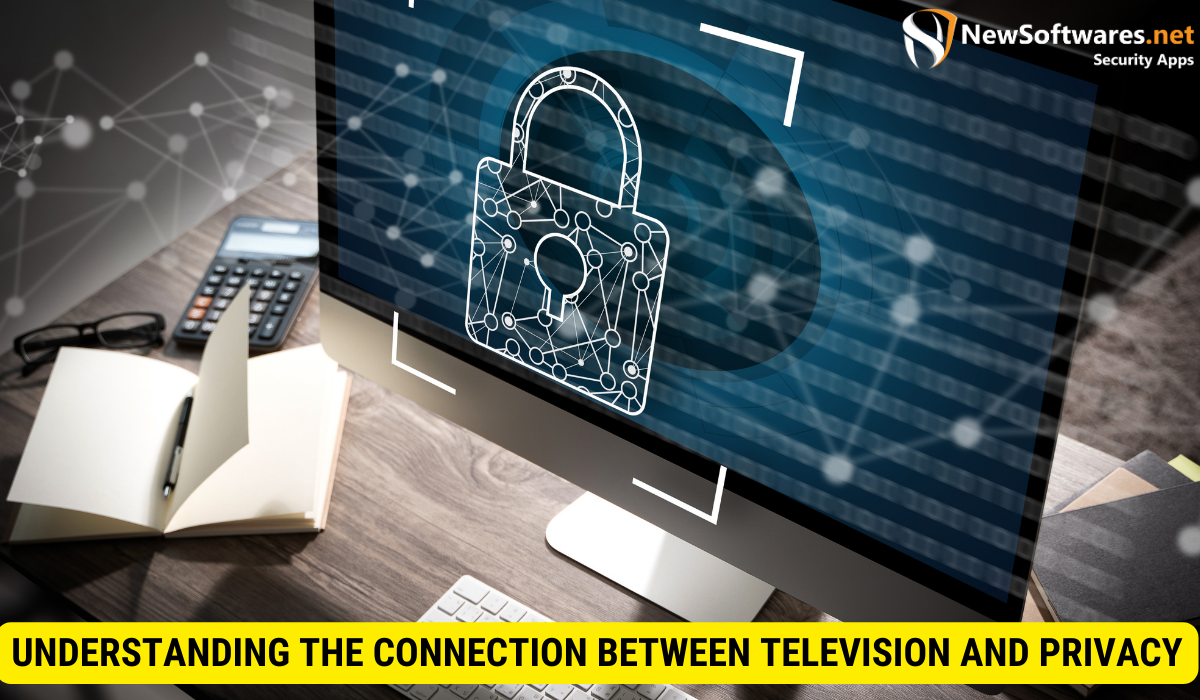Televisions, especially smart TVs, collect personal data and privacy information through various means, including data transmission over the internet. This data collection occurs when you interact with your TV, change channels, use applications, or even issue voice commands. Your viewing habits, watched content, visited websites, location, and personal preferences are types of data collected.
The television is not just a source of entertainment anymore. It has become a powerful tool for collecting and storing personal data. Together, we will explore how televisions obtain your privacy and personal data and the steps you can take to protect yourself.”
Understanding the Connection Between Television and Privacy

Before delving into the details of how televisions collect your information, it’s important to understand the evolution of television technology. Over the years, televisions have transformed from simple devices that transmit broadcast signals to sophisticated smart TVs that connect to the internet and gather data.
The Evolution of Television Technology
Televisions have come a long way from the humble black and white sets of the past to today’s sleek, high-definition screens. Technological advancements have allowed televisions to receive signals, connect to the internet, stream content, and interact with various applications.
In the early days of television, viewers were limited to a few channels and had to manually adjust the antennas to get a clear reception. Color televisions were introduced as technology progressed, bringing a more immersive viewing experience. The advent of cable and satellite television expanded the range of available channels, providing viewers with a wider selection of programs.
However, the introduction of smart TVs truly revolutionized the television industry. These intelligent devices allow users to watch their favorite shows and movies and provide access to a multitude of online content. Smart TVs can connect to the internet with built-in Wi-Fi capabilities and stream videos from popular platforms like Netflix, Hulu, and YouTube.
The Role of Smart TVs in Data Collection
Smart TVs have revolutionized the way we interact with our televisions. These intelligent devices come equipped with built-in cameras, microphones, and sensors to gather information about our viewing habits, preferences, and even our physical surroundings.
For instance, smart TVs can analyze the content we watch, the duration of our viewing sessions, and the frequency of our channel changes. This data is then used to personalize our viewing experience by recommending shows and movies that align with our interests. Additionally, smart TVs can collect information about our internet usage, such as the websites we visit and the apps we use.
Privacy concerns arise when considering the extent to which smart TVs collect and store this data. While manufacturers claim that the information is used solely to enhance the user experience, there is always the potential for misuse or unauthorized access. Users need to be aware of the privacy settings on their smart TVs and take necessary precautions to protect their personal information.
Furthermore, the integration of voice recognition technology in smart TVs raises additional privacy concerns. By using voice commands, users can control their televisions without the need for a remote. However, this convenience comes at a cost. In order to process voice commands, smart TVs must constantly listen for specific trigger words, which means that they are essentially always “listening” to the conversations happening in the room. While manufacturers assure users that these conversations are not recorded or stored, the potential for privacy breaches remains.
In conclusion, the evolution of television technology has brought about significant advancements in the way we consume and interact with media. Smart TVs, with their ability to connect to the internet and gather data, have transformed the television viewing experience. However, it is crucial for users to be aware of the potential privacy implications and take necessary measures to protect their personal information.
The Mechanics of Data Collection Through Television
To understand how televisions collect data, it’s important to grasp the process of data transmission and the types of information that are collected.
When you connect your smart TV to the internet, it becomes a gateway for data transmission. Every interaction you have with your television, such as changing channels, searching for content, or using applications, can potentially be recorded and sent to various servers.
But how exactly does this data transmission work? Let’s delve deeper into the intricacies of the process.
Data Transmission: How Your Information is Sent
When you perform an action on your smart TV, such as selecting a channel or launching an app, the television’s operating system processes your command and generates a data packet. This data packet contains information about the action you performed, including the time, date, and the specific command itself.
Once the data packet is generated, it needs to be sent to its destination. This is where the internet connection comes into play. Your smart TV establishes a connection to the internet through either a wired or wireless network. The data packet is then encapsulated into smaller units called packets, which are transmitted over the network.
These packets traverse a complex network infrastructure, consisting of routers, switches, and various other networking devices. Each device along the path examines the destination address of the packet and forwards it accordingly, ensuring that the data reaches its intended recipient.
Upon reaching the destination server, the data packets are reassembled and processed. The server then stores this information in a database, where it can be analyzed and utilized for various purposes.
Types of Data Collected by Your Television
Televisions have the ability to collect various types of data, including but not limited to:
- Your viewing habits
- The content you watch
- The websites you visit
- Your location
- Your personal preferences
Let’s explore each of these types of data in more detail.
Your viewing habits provide valuable insights into the type of content you enjoy. By analyzing the shows, movies, and genres you watch, content providers can recommend similar content that aligns with your interests. This personalized recommendation system enhances your viewing experience by suggesting relevant and engaging content.
The content you watch is another crucial piece of data collected by your television. This information helps content providers understand which shows and movies are popular among viewers. By analyzing this data, they can make informed decisions about what content to produce or acquire, ensuring that they cater to the preferences of their audience.
When you browse the internet using your smart TV, the websites you visit are also recorded. This data allows manufacturers and advertisers to gain insights into your online behavior. For example, if you frequently visit websites related to fitness, you may start seeing advertisements for fitness equipment or workout programs on your television.
Your location information is collected to provide localized content and services. For instance, if you are in a specific region, your television can display news, weather updates, and advertisements that are relevant to that location. This personalized approach ensures that you receive information that is specific to your geographical area.
Finally, your personal preferences are collected to tailor the user experience. By understanding your preferences, manufacturers can customize the interface, settings, and features of your television to suit your needs. This level of personalization enhances user satisfaction and makes the television more user-friendly.
It’s important to note that while this data collection can raise privacy concerns, manufacturers and content providers are bound by privacy regulations and policies. They must handle your data responsibly and ensure that it is used in a secure and ethical manner.
In conclusion, the mechanics of data collection through television involve the transmission of data packets over the internet, capturing various types of information such as viewing habits, watched content, visited websites, location, and personal preferences. This data is then utilized to enhance the user experience, provide personalized recommendations, and deliver targeted advertisements.
The Role of Third-Party Applications in Data Collection
While smart TVs offer a wealth of features and applications, it’s important to be aware that some of these third-party applications may have access to your personal data.
Streaming Services and Data Privacy
Streaming services, such as Netflix and Hulu, often require access to your personal information to personalize your experience and suggest content you might enjoy. While this can enhance your viewing experience, it’s important to carefully review the privacy policies of these services and understand how they handle your data.
Gaming Consoles and Television Data Collection
Gaming consoles that are connected to your television, such as PlayStation and Xbox, also have the potential to collect data. This includes information about your gaming habits, preferences, and even your social interactions while gaming online.
The Legal Aspects of Television Data Collection
Regulations surrounding television data collection vary across different regions. Understanding your rights and the privacy policies of the manufacturers and content providers is crucial in protecting your personal data.
Privacy Policies: What You Need to Know
Manufacturers and content providers typically have privacy policies that outline how your data is collected, stored, and shared. It’s important to read and understand these policies to make informed decisions about your privacy.
Consumer Rights and Television Data Collection
Consumer protection laws vary, but many regions have enacted regulations that safeguard individuals’ personal data. It’s important to familiarize yourself with these laws and understand your rights as a consumer.
Protecting Your Privacy: Steps to Take

While it may seem daunting, there are several steps you can take to protect your privacy when using a smart TV.
Adjusting Television Settings for Privacy
Start by reviewing and adjusting the privacy settings on your smart TV. Disable any features or permissions that you find unnecessary or intrusive. This can include disabling voice recognition, camera access, or data sharing with third-party applications.
The Importance of Regular Software Updates
Keep your smart TV’s software up to date. Manufacturers often release updates that include security patches and improvements to privacy settings. Regularly check for updates and install them to ensure your television is protected against potential vulnerabilities.
Alternatives for Privacy-Conscious Viewers
If protecting your privacy is a top concern, you may consider using alternative devices, such as streaming media players or dedicated gaming consoles, that offer greater control over your data. These devices often provide more transparent privacy settings and may give you peace of mind.
Key Takeaways
Television data collection has become a widespread practice due to the advancement of technology and the proliferation of smart TVs. To protect your privacy, it’s important to understand the data collection process, review privacy policies, and adjust settings according to your preferences. Regularly updating your television’s software and considering alternative devices can also enhance your privacy protection.
FAQs
Can I completely prevent my television from collecting data?
While it may be challenging to entirely prevent data collection by your television, adjusting privacy settings, disabling unnecessary features, and being cautious about the applications you use can significantly reduce the amount of information collected.
Do all manufacturers have the same privacy policies?
No, privacy policies can vary among manufacturers and content providers. It’s essential to review each company’s privacy policy and ensure it aligns with your expectations and preferences.
What are the potential risks associated with television data collection?
The risks associated with television data collection include potential breaches of personal information, targeted advertising, and the potential for your data to be shared with third parties without your consent. Understanding and managing these risks is crucial for protecting your privacy.
Conclusion
By taking the necessary precautions and staying informed about privacy practices, you can enjoy the benefits of your smart TV while minimizing the potential risks to your privacy and personal data.
